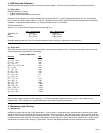
page 5
OMEGA PHE/ORE Series pH/ORP Electrode Instructions
4. ORP Electrode Calibration
All ORP electrodes are designed to ensure linearity during their lifespan. The following sections define proper electrode operation.
4.1 Offset (STD)
Electrode offsets occur due to:
• Clogged reference junction
• Aged or contaminated reference solution/wire
Offsets are easily checked in pH 7 buffer saturated with quinhydrone @ 25 °C; since the theoretical output is +87 mV. Any deviation
from +87 mV is the ORP electrode offset (i.e. +90 mV). Quinhydrone is the oxidizer measured by the ORP electrode and is required for
calibration. To guarantee buffer saturation, mix 1/8g quinhydrone per 50 mL of pH buffer.
ORP Electrode Offset:
Solution: pH 7 or pH 4 buffer saturated with Quinhydrone @ 25 °C
pH 7 + Quinhydrone pH 4 + Quinhydrone
Theoretical mV: + 87 mV + 264 mV
New: 87 ± 15 mV +264 ± 15 mV
Reliable: 87 ± 50 mV +264 ± 50 mV
Electrode offsets greater than ±50 mV indicate the electrode requires cleaning or replacement, see section 5.2.
4.2 Slope (SLP)
ORP slope errors are generally caused by contamination of the platinum electrode surface. Cleaning the electrode surface will usually
restore proper values, response time, and stability.
Common ORP Values
Reaction mV
Cr → Cr
2+
+ 2e
-
- 913
Fe
→ Fe
2+
+ 2e
-
- 440
Cr
2+
→Cr
3+
+ e
-
- 407
4OH
-
→ O
2
+ 2H
2
O + 4e - 401
2I
-
→ I
2
+ 2e
-
- 400
Ti
2+
→ Ti
3+
+ e
-
- 370
Ni → Ni
2+
+ 2e
-
- 250
Pb → Pb
2+
+ 2e
-
- 126
Fe → Fe
3+
+ 3e
-
- 37
H
2
→ 2H
+
+ 2e
-
0
Fe
2+
→ Fe
3+
+ e
-
+ 771
Ag → Ag
+
+ e
-
+ 799
Pb → Pb
4+
+ 4e
-
+ 800
3Br
-
→ Br
3
-
+ e
-
+ 1060
2Br
-
→ Br
2
+ 2e
-
+ 1066
ClO
2
-
→ ClO
2
+ e
-
+ 1160
Pt → Pt
2+
+ 2e
-
+ 1188
Ag → Ag
2+
+ 2e
-
+ 1369
Many systems require both pH and ORP calibration. To conserve calibration reference solutions, use pH 7 and 4 buffers for pH
calibration first. ORP calibration can be performed with the same buffers by adding quinhydrone.
5. Maintenance and Cleaning
5.1 Maintenance
Variables can affect long term pH or ORP electrode life. For this reason, a maintenance log is recommended for trend analysis. When
storing boxed sensors, lay the sensor flat to maximize hydration of the glass surface. Keep the glass surface wet at all times. Soak the
sensor tip in pH 4.0 buffer during system maintenance intervals. In-line applications should be plumbed with a depression (trap) so liquid
is maintained around the sensor tip. If the sensor dehydrates, soak the sensor tip in pH 4 buffer for 24 to 48 hours, then visually inspect
the electrode for surface cracks, swelling, or discoloration. Severely dehydrated electrodes cannot be restored to normal operation.










